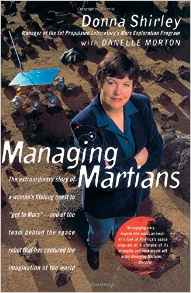
Back to Women in STEM book reviews! This week’s book is Managing Martians by Donna Shirley with Danelle Morton. Donna Shirley is not related to Dame Stephanie Shirley whose book Let IT Go was reviewed earlier in this series.
Managing Martians begins on July 4, 1997 with the arrival of the lander Pathfinder and the rover Sojourner Truth on Mars. Shirley describes the importance of that day to her. “I headed the team that had designed and built this revolutionary six-wheeled scientific laboratory [Sojourner Truth], a 25-pound robot about the size of a microwave oven that could do what humans could only dream of: explore the surface of Mars.”
This book tells the story of how a girl, born in 1941 and raised in a small town in Oklahoma, became the woman who could write that sentence. Early in her life she became interested in aviation. She made her first solo flight in an airplane at the age of fifteen. As a young person her goal in life was to become an aeronautical engineer. Like many woman of her era, she was told that “Girls can’t be engineers.” In her case it was how she was greeted by her college engineering advisor. After she assured him that she had been accepted into the College of Engineering he did look for and find her student folder.
After a rocky start to her career, Shirley was hired by JPL’s aerodynamics group in 1966. It was the start of her thirty-one year effort to get to Mars.
Managing Martians provides an inside look at both the technical and the management details of the space program.
The sections of the book that describe the different types of rovers that were built and tested on Earth before the design of Sojourner Truth was decided upon is fascinating. The tradeoffs of function and weight are explained. Weight (or more technically correct – mass) was a major factor in every decision that was made. From how smart the rover would be to how much battery backup power it would have.
The issue of mass also impacted the lander Pathfinder. The problems encountered during the testing of the material to provide the protection for the lander as it crashed into the surface of Mars were made more difficult by the need to keep the mass of the material to a minimum.
Shirley really shines during the sections that cover the management of space projects. Her approach to managing technical staff where they clearly knew more about the technology than she did was daring, trusting and successful. As a technical person who has worked for more than one manager who seemed determined to undermine my ability to accomplish anything, I would have loved to have had Shirley for a boss. She also brought women onto her teams and recounts one small planning session where she suddenly realized that everyone in the meeting was female.
She talks about the money constraints of space projects as NASA moved into a period of “Better, Faster, Cheaper” after the end of the Apollo moon landings. Her ability to manage these constraints allowed her to, as she put it, “bend the glass ceiling” and be promoted over some of her male peers.
Managing Martians is well worth reading both as a history of the time and as a management primer.
If you have enjoyed this post please share it with others using the buttons below.
Please let me know of your experiences as a woman in STEM or any other experience you wish to share by leaving a comment.
This is like being able to peek under the hood of the Mars rover – how cool!
I was going to just push the like button but for some reason I can’t do that from my dashboard. Thanks for being interested.
That book sounds really good. I’m looking forward to reading it. The space program is something that is always cool!
One of the fun things is comparing this first Mars rover with the ones currently on Mars. Let me know how you liked the book